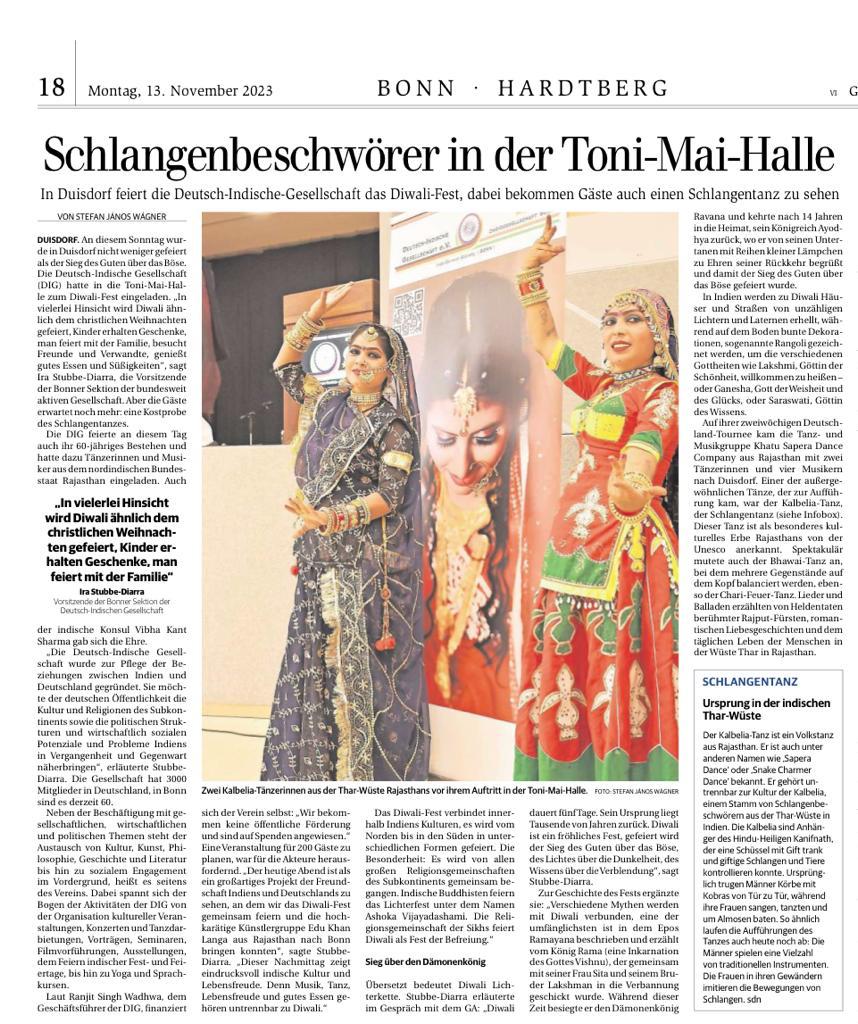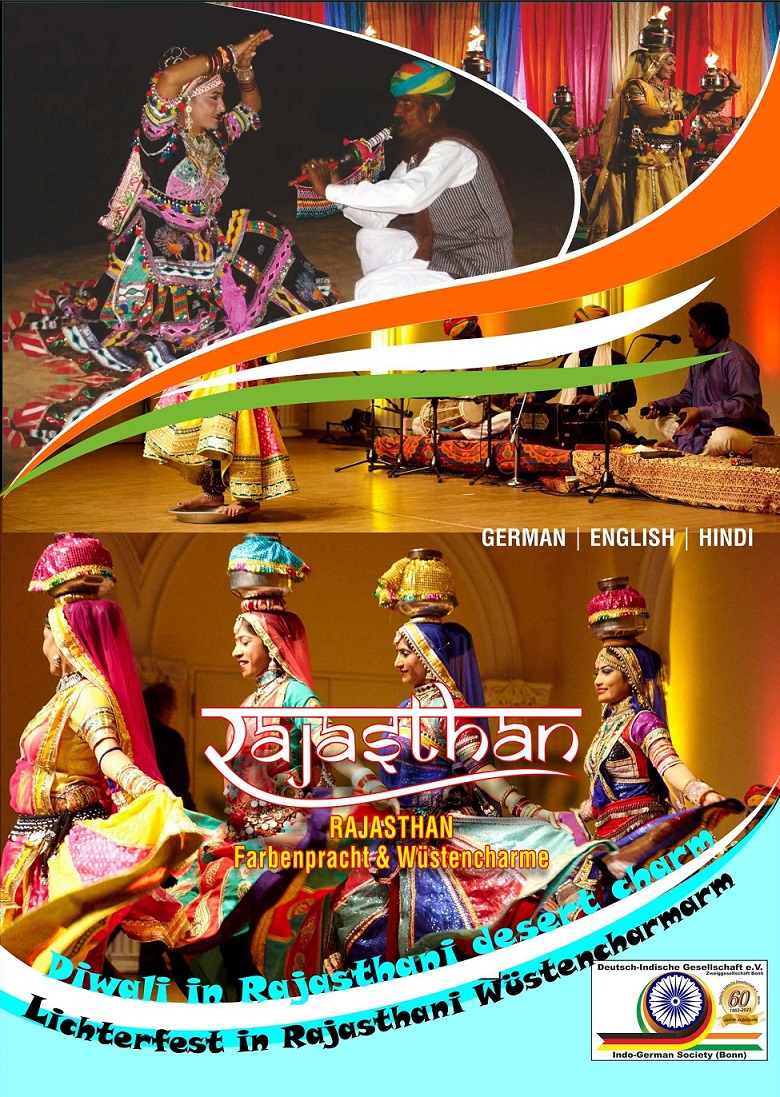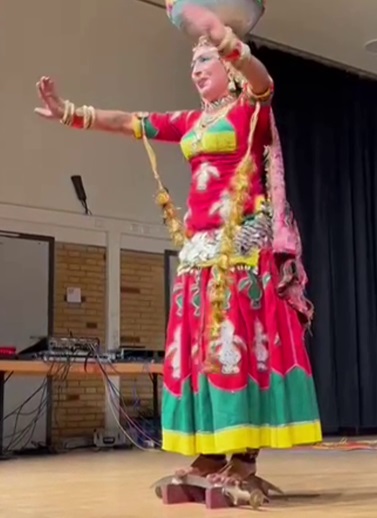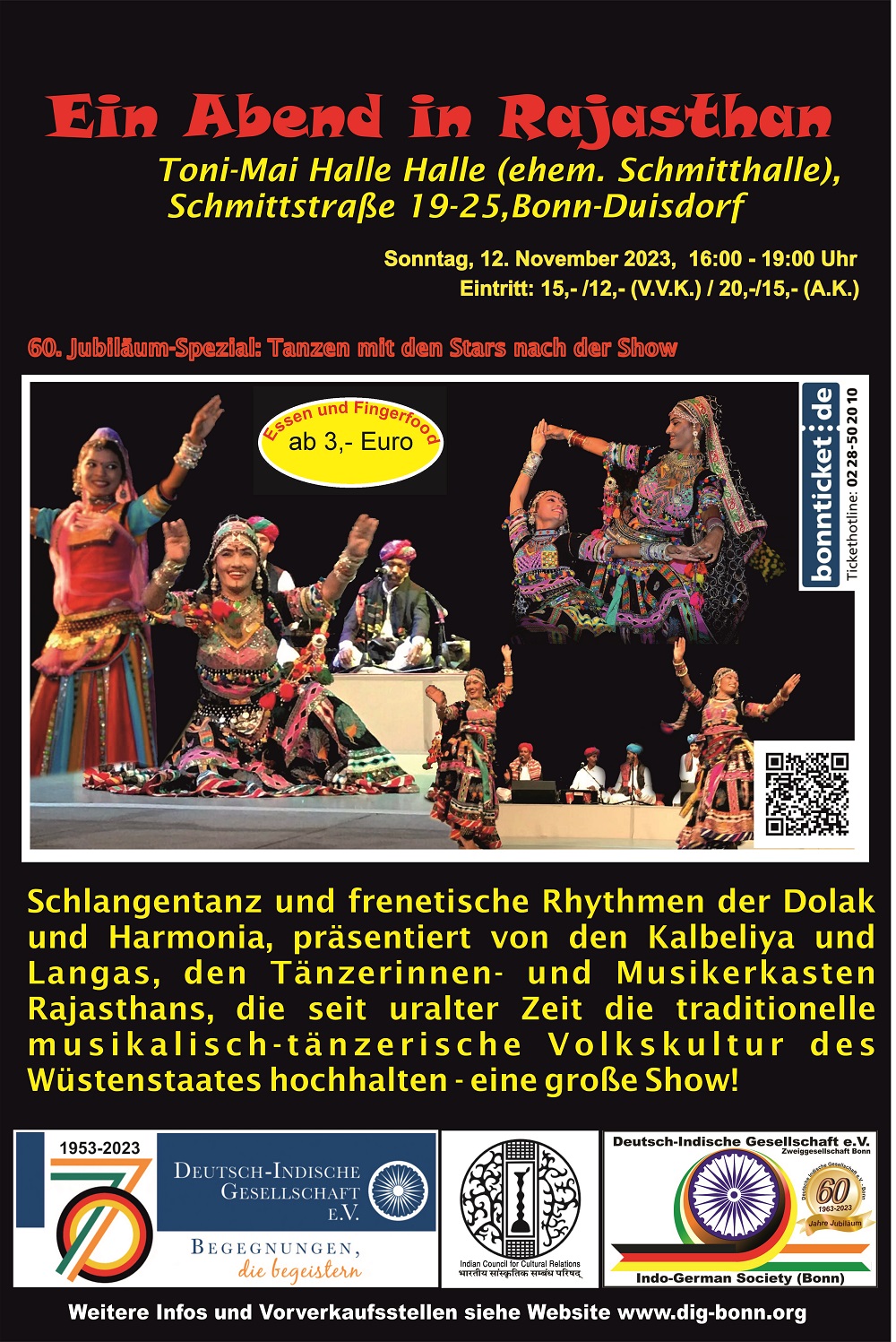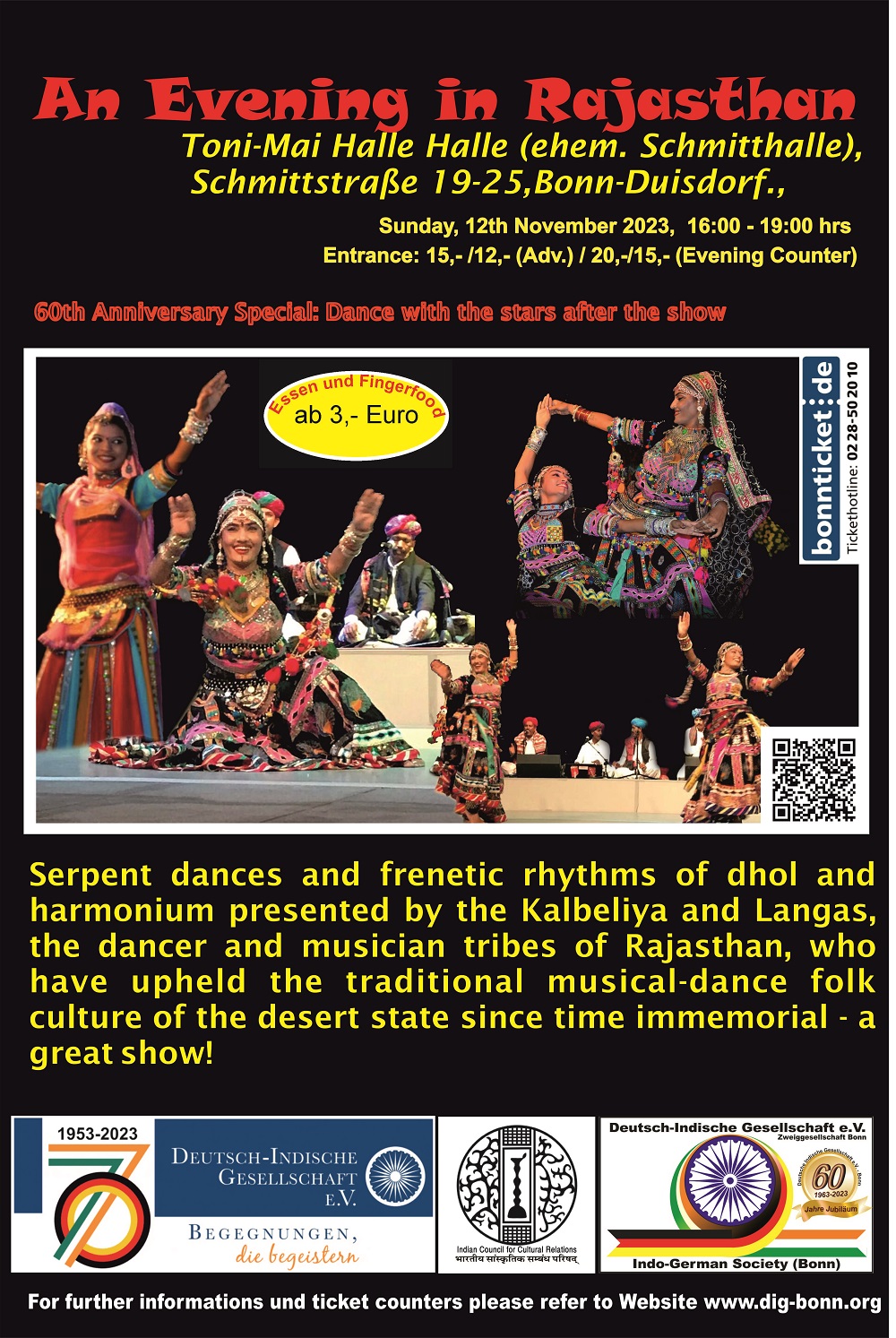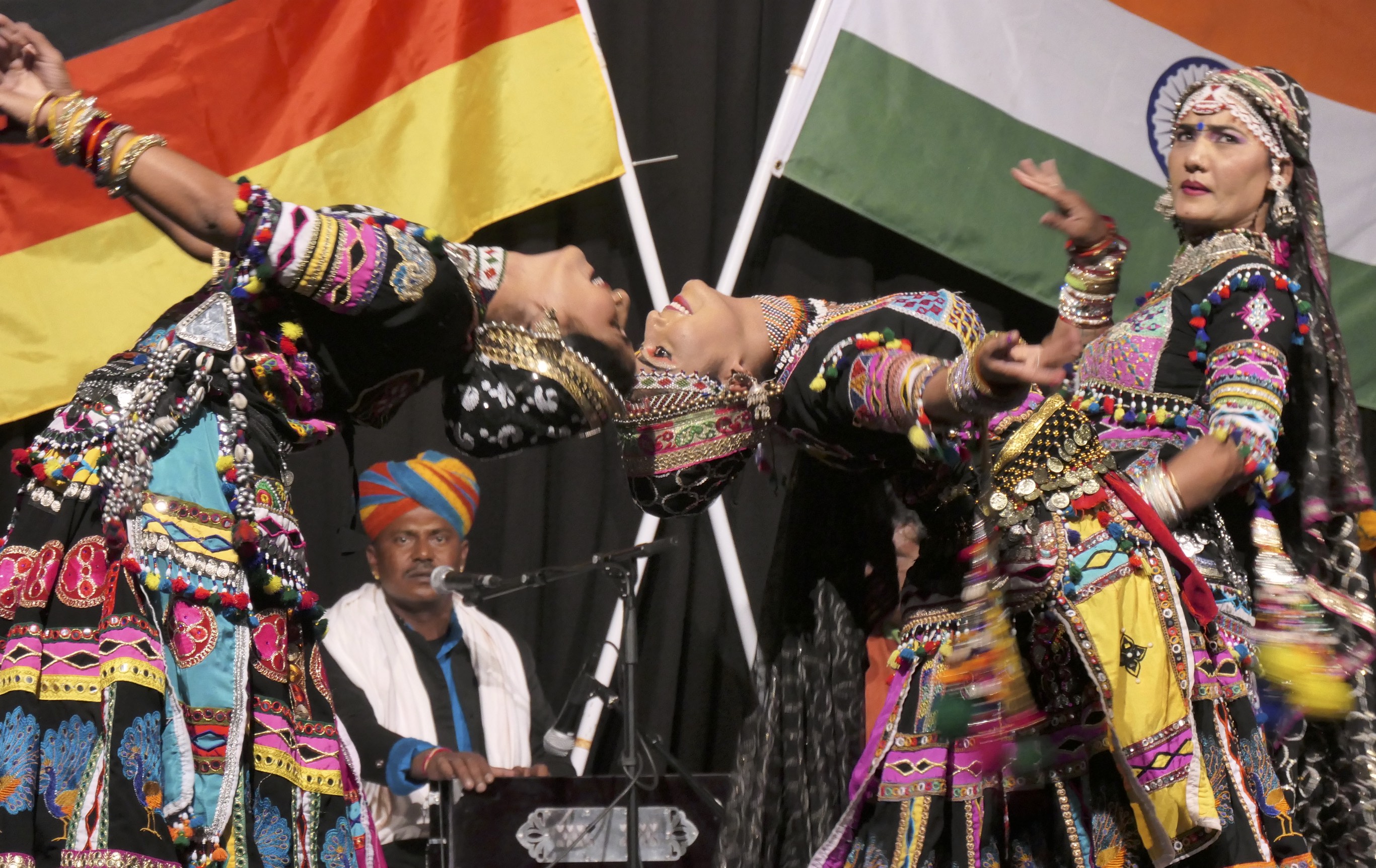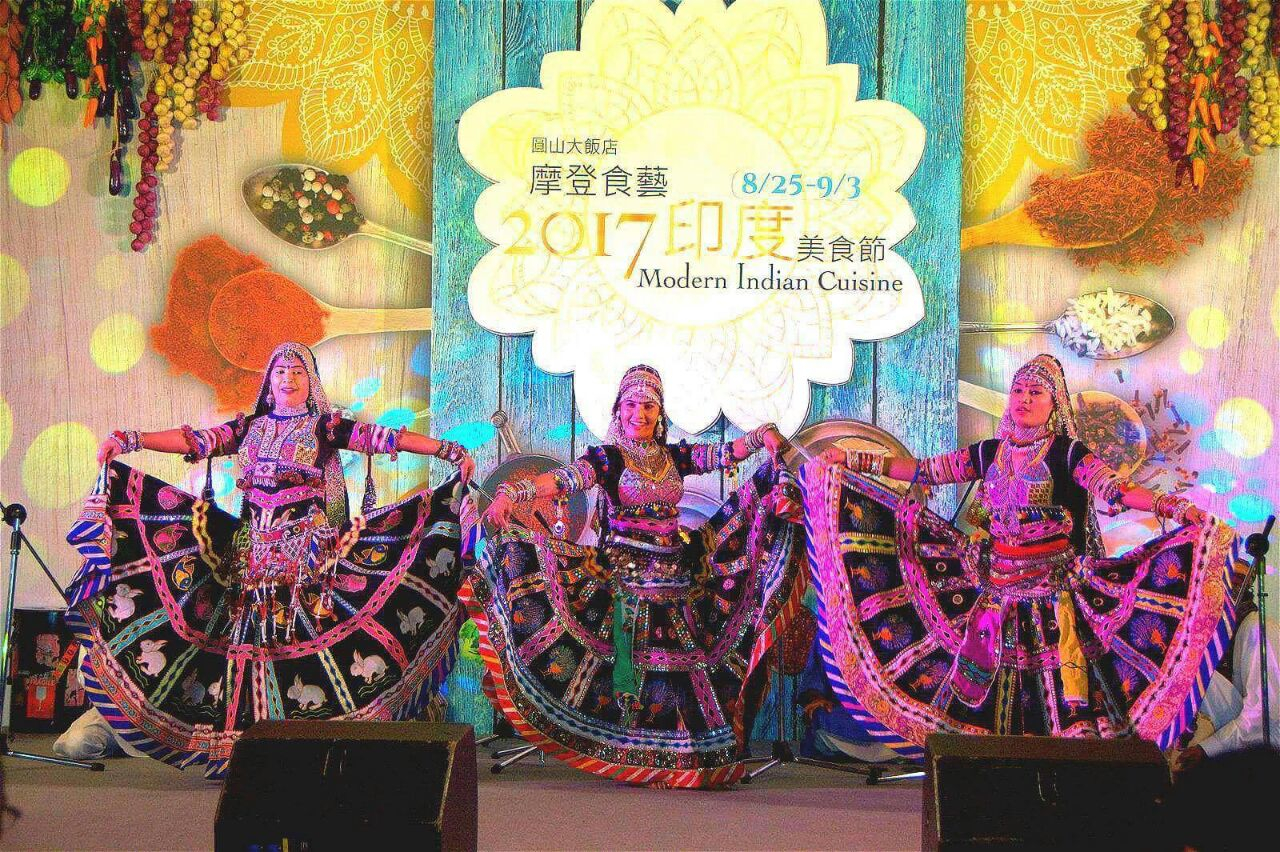Download Booklet
( The hardcopy will be available at the Evening counter.
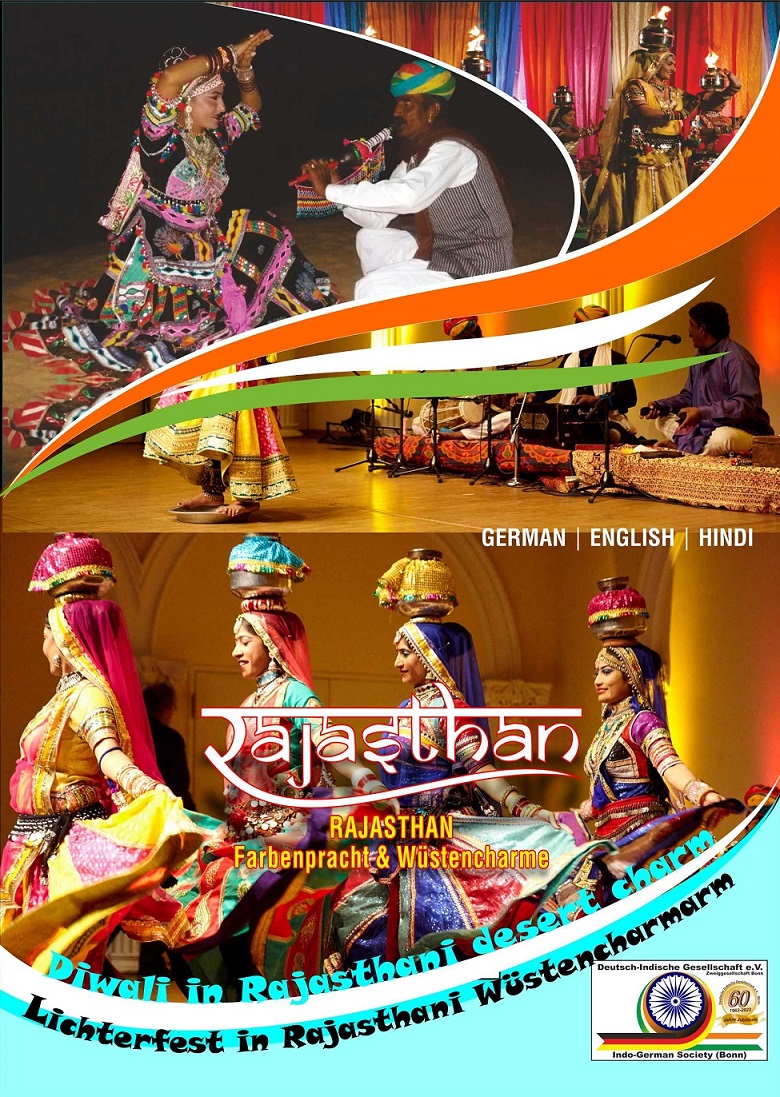 Jeder Gast ist berechtigt, eine Broschüre über Diwali und Rajasthan mitzunehmen. Diese Broschüre umfasst über 50 Seiten und wurde von verschiedenen Autoren auf freiwilliger Basis verfasst.
Jeder Gast ist berechtigt, eine Broschüre über Diwali und Rajasthan mitzunehmen. Diese Broschüre umfasst über 50 Seiten und wurde von verschiedenen Autoren auf freiwilliger Basis verfasst.

|
Programm: 17:15 Pause 17:45 Tanz und Musik Veranstaltung Teil-2 18:45 Vote of Thanks 19:00 Tanz mit den Künstlern |

About the Dances / Über die Tänze
Der indische Bundesstaat Rajasthan ist Heimat der verschiedensten Tanz- und Musikstile, die ihren Ursprung und ihre kulturelle Vielfalt in der jahrhundertealtenTradition der Rajputen-Könige hat. Die Farbenpracht der Königspaläste verbindet sich mit der Einfachheit und Kargheit der Thar-Wüste und gibt den Tänzen und Musik der Region einen einzigartigen Charme und Rhythmus.
Die Musiker enstammen der Langha-Gemeinschaft von Barmer und Jaisalmer in Rajasthan. Die Manganiyar - ebenso wie die Langha-Gemeinschaft - sind weltweit bekannt für ihre Musikdarbietungen und die Pflege der musikalischen Tradition der Thar Wüste Rajasthans.
Die Langhas sehen sich als Rajputen und Charan Gemeinschaft und gehören sowohl hinduistischen als auch muslimischen Glaubensgemeinschaften an, während die Langha als Gemeinschaft der Sindhi-Sipahi, eine Muslim Rajputen Gemeinschaft sind. Die weltoffenen Manganiyars, die sich auch mystischen Sufi-Traditionen zuwenden, bieten dazu hinduistische epische Poesie dar und besingen in Balladen ihre Patrone, spielen auf Hochzeiten und anderen Festen.
Die Tänzerinnen Amki und Nagina Sapera entstammt einer Familie von Schlangenbeschwörern und Tänzern, die der Kalbeliya Jogi Gemeinschaft angehören und in Jodhpur, Rajasthan, lebt und arbeitet. Diese pflegt nicht nur die Volksmusik- und Volkstanztraditionen Rajasthans, sondern entwickelt die Technik und Formen entscheidend weiter. In dieser Tradition steht Khatu Sapera, die die Kalbeliya Tanzform seit ihrer frühesten Kindheit erlernte und diese mit den Jahren weiterentwickelt und verfeinert hat. Sie unterrichtet diese Tanzform und hat ein Tanz- und Musikensemble gegründet, das ihre Musiktraditionen in ganz Indien und auch im Ausland vorstellt und durch zahlreiche Auftritte international bekannt gemacht hat. Viele Regierungen und kulturelle Institutionen haben Ihr für Ihre Arbeit Ehrungen und Preise verliehen. Schließlich ist der Kalbeliya-Tanz als besonderes kulturelles Erbe Rajasthans von der UNESCO anerkannt.
Als weitere Tänze werden dargeboten der Bhawai-Tanz, bei dem mehrere Gegenstände auf dem Kopf balanciert werden, sowie der
Chari-Feuer-Tanz. Beide Tänze spiegeln das Leben der Frauen und den Alltag der Frauen Rajasthans wider, die lange Wege mit Töpfen auf dem Kopf gehen, um Wasser zu holen, doch werden in den Töpfen (Chari) auch andere Gegenstände transportiert, so auch brennende Töpfe mit Öl- Baumwollsamen.
Ensemble/Tänzerinnen: Ms. Amri Sapera & Ms. Nagina Sapera
Musiker und Vokalsänger:
Swarup Khan - Gesang
Kasam Khan - Harmonium, Gesang
Bacchu Khan - Khartal, Gesang
Roshan Khan - Dholak
Ms Amki &Ms Nagina - Tänzerinnen
The Indian state of Rajasthan is home to a wide variety of dance and music styles, which has its origins and cultural diversity in the centuries-old tradition of the Rajput kings. The colourfulness of the royal palaces combines with the simplicity and barrenness of the Thar Desert to give the dances and music of the region a unique charm and rhythm.
The musicians come from the Langa community of Barmer and Jaisalmer in Rajasthan. The Manganiyar - as well as the Langa community - are known worldwide for their musical performances and for maintaining the musical tradition of the Thar Desert of Rajasthan.
The Langas consider themselves a Rajput and Charan community and belong to both Hindu and Muslim faith communities, while the Langa as a Sindhi-Sipahi community, are a Muslim Rajput community. The cosmopolitan Manganiyars, who also embrace mystical Sufi traditions, offer Hindu epic poetry and sing the praises of their patrons in ballads, performing at weddings and other festivals.
The dancers Amki and Nagina Sapera come from a family of snake charmers and dancers who belong to the Kalbeliya Jogi community and live and work in Jodhpur, Rajasthan. This not only maintains the folk music and folk dance traditions of Rajasthan, but also significantly develops the technique and forms. In this tradition is Khatu Sapera, who learned the Kalbeliya dance form since her earliest childhood and has developed and refined it over the years. She teaches this dance form and has established a dance and music ensemble that presents her musical traditions throughout India and also abroad and has gained international recognition through numerous performances. Many governments and cultural institutions have awarded her honours and prizes for her work. Finally, the Kalbeliya dance is recognized as a special cultural heritage of Rajasthan by UNESCO.
Other dances performed include the Bhawai dance, which involves balancing several objects on the head, and the Chari fire dance.
Chari fire dance. Both dances reflect the lives of women and the everyday life of the women of Rajasthan, who walk long distances with pots on their heads to fetch water, but the pots (chari) also carry other objects, including burning pots of oil cotton seeds.
Ensemble/Dancers: Ms. Amki Sapera & Ms. Nagina Sapera
Musicians and Vocal Singer:
Swarup Khan - Vocal
Kasam Khan - Harmonium, Vocal
Bacchu Khan - Khartal, Vocal
Roshan Khan - Dholak
